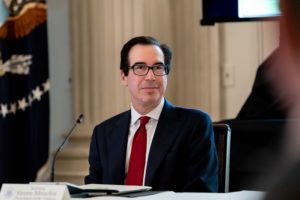
Treasury Secretary Steven Mnuchin participates in a roundtable with executives in the State Dining Room of the White House Wednesday, April 29, 2020, to discuss a plan to reopen America. (Official White House Photo by Andrea Hanks)
Late yesterday, Treasury Secretary Steve Mnuchin announced the unprecedented amount of central bank intervention in private credit markets would end on December 31st. The Fed of course announced it was disappointed the Treasury Secretary was taking away one of their abilities to manipulate asset markets, but Mnuchin did it anyway. The WSJ has more.
Congress provided $454 billion in March to the Treasury to backstop loans made by the Fed, and Mr. Mnuchin quickly made $195 billion of that money available for five lending programs that will now end on Dec. 31. The Treasury has provided half of the $195 billion to limited liability corporations set up at the Fed to make loans and buy assets.
The programs have generally been lightly used, but for different reasons. In some cases, such as corporate-debt backstops, lower volumes reflect the success the mere announcement of the Fed backstops has had in spurring private investors to buy assets. The Fed, for example, promised to purchase up to $750 billion in debt of large companies that had been rated investment-grade as of March 22, but it ended up buying much less—around $13.5 billion as of Wednesday.
In others, such as the Main Street Lending Program for small and midsize businesses, low uptake reflects complications the Fed and Treasury encountered launching the program and enticing banks and borrowers to use it.
Several presidents of Federal Reserve Banks, who have no formal role in deploying the lending facilities, had argued strongly in public in recent days that the programs should be extended.
The Fed cut its benchmark short-term rate to near zero in March and has purchased trillions of dollars of government debt and federally backed mortgage bonds. With those conventional tools potentially exhausted, the emergency loan programs represented one way the Fed might be able to expand its policy response should market or economic conditions deteriorate further this winter.
In his letter Thursday, Mr. Mnuchin asked the Fed to return more than $70 billion in funds that had already been transferred to the central bank to cover loan losses and that won’t be needed as a result of lower lending volumes.
It wasn’t clear Thursday if the Fed would do so. It is possible the Biden administration and the Fed could resume the lending programs after President-elect Joe Biden is sworn in on Jan. 20. The Fed’s board and the Treasury secretary must both agree to start any new loan programs by citing “unusual and exigent” circumstances.
Read more here.
